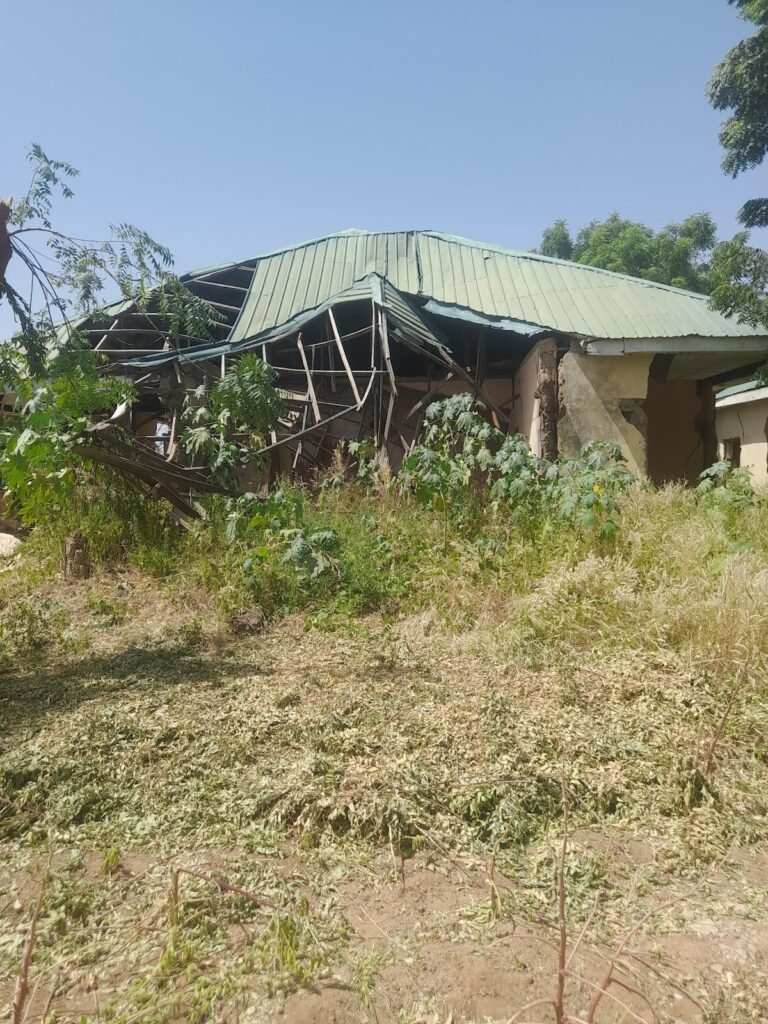This is the second and concluding part of a series on abandoned clinics and neglected staff in Sokoto State. The first part can be read here.
In 2017, the Federal Government flagged off the Primary Health Centre (PHC) revitalisation programme, where it committed to revitalizing 10,000 PHCs across the country with at least one centre in each of Nigeria’s 109 senatorial districts.
Unfortunately, findings show about 80 percent of facilities in Nigeria are still non-functional. According to the World Health Organisation (WHO), only a quarter of PHCs in Nigeria have more than 25 per cent of the minimum required equipment package, adding that “the capacity to provide basic emergency obstetrics services is limited to about 20 percent of the PHC facilities.
Illa Health Clinic in the Gada local government area of Sokoto state is one such facility that lacks the minimum required equipment package. Also, the PHC falls short of the minimum standard recommended by the National Primary Health Care Development Agency (NPHCDA), particularly in terms of infrastructural and ill-equipments.
NPHCDA says an ideal primary health centre should have a minimum of 24 staff. It also recommended that a standard PHC should have one medical officer “if available”; one community health officer (CHO); four nurses or midwives; three CHEW; one pharmacy technician; six JCHEW; one environmental officer; one medical records officer; and one laboratory technician.
For supporting staff, NPHCDA states that the health centres should have two health attendants, two security personnel and one general maintenance staff. And there should be a well-equipped open ward, labour room, children and female wards, doctor’s office and staff quarters, an ambulance for referrals and drugs and equipment for immunization, preventive and basic curative care. Unfortunately, Illa Health Clinic draws far from the required standard.
The Journey to Illa Health Clinic Facility
It was on Thursday, 26th October 2023. The usual scorching sun in Sokoto was beaming its way above the earth as I set out on my journey to Gada, a remote town in the eastern part of Sokoto State.
Squeezed into the middle of three hefty market women at the back sitter of a commercial car, my left leg almost stopped functioning with the way I positioned it in a single spot for over an hour. I gave up. I screamed at the driver that I couldn’t continue the journey in that position. The driver asked a passenger sitting at the front seat to stand up for substitution. Luckily for me, the passenger, a slim dark young man in his early 30s, did not trade words with the driver. He humbly obeyed, perhaps, because the driver is an elderly person.
At the front seat, I was paired with a man who had been discussing with the driver about the latest attack by unknown gunmen at some villages in the eastern part. I gave him all my attention, even though I didn’t understand the Hausa language to the fullest, I could grasp the subject matter of the discussion.
Anyways. It was a smooth drive to Gada, from Sokoto, the capital city of Sokoto state. My only concern—after switching position in the car— throughout the journey which lasted for about three hours was the news of insecurity blurring the picture of the eastern part of the state. I was praying not to fall victim.
When I reached Gada, I decided to get a fixer to lead me to Illa Health Clinic, which was the second primary health centre I intended to visit that day in the area.
The road from Gada to Illa PHC/photo:Shereefdeen Ahmad
However, from Gada, the landscape of my journey changed: It was no longer a smooth drive. The road, littered with potholes and sand hills, seemed abandoned.
My fixer, who doubled as my bike man, held the two hands of the fairly used motorcycle with utmost care. But even at that, the sandhill, on several occasions, used to take control of the motorcycle from his hand, thereby packing us by the roadside.
The man, a fairly looking man in his early 40s with beards spread across his cheek, would hiss and shake his head each time the sandhill forced us to the roadside. “Imagine!,”he said. “I used to wonder if the government really knew about our existence, unless it’s time for elections.”
He complained bitterly about the condition of the road. Meanwhile, I didn’t develop interest in his wailing, because the constant reportage of incessant attacks and abductions in those places by gunmen still rang a bell in my mind.
But the man said something about the road which woke me up from my reverie: “Assuming someone has an emergency, how do you expect the person to drive quickly to the PHC with the condition of this road?”
I began to interpret his statement as a precursor to the picture of the Illa Health Clinic: bad road, perhaps, poor facility.
The facility, situated along Dukamaje road, is about eight to ten kilometres away from Gada.
Inside Illa Health Clinic
Aside from the sight of the patients who hovered around the premises, nothing gave me the impression that I had reached our destination.
When we entered the facility, the residents who came for treatment from surrounding villages seemed to be familiar with my fixer. It was then that he revealed to me that he was a staff member of the facility. But he used to come from Gada every day because there were no staff quarters.
“I wish we had a staff quarter, I would have stayed there rather than riding on this bumpy road every day,” my fixer and staff of the facility who wanted not to be named for fear of victimization, said.
Though the facility had a staff quarter, the building had crumbled. The fixer said it crumbled shortly after its completion and it was never used.
It has become a haven for all sorts of reptiles. A tour around it showed that half of the roofing was out, the ceilings dangling; some of the walls had fallen while the remaining ones stood cracked. The entire building has now been taken over by outgrown grasses.
Dilapidated staff quarters of Illa PHC/photo: Shereefdeen Ahmad
Entering the facility, a ceiling board dangling from the top welcomed us, while some pieces littered the floor in different corners of the building.
In the wards, most beds either had worn-out mattresses or were without one. Patients were seen sitting all over, waiting for the doctor to attend to them.
The condition of the facility is not unique. According to data collected by Orodata Science in partnership with Africa Data Hub, 74% of PHCs across the Sokoto State have damaged hospital beds.
A ward in Illa PHC/photo: Shereefdeen Ahmad
We entered a small room where dust danced lazily in the air. The room has a single rickety bed with a broken door. Beside it, there’s a similar room of the same size.
“The two rooms are built as toilets but we converted one of them as a delivery room because the facility does not have one,” my fixer said.
The delivery room/Photo: Shereefdeen Ahmad
The only consulting room, like other rooms, was roped with cobwebs. Patients flooded the door, jostling to enter the room.
One such patient is Aishah Shafaatu. She looked weary and tired as she struggled to push out words from her mouth. Aishah hoped the facility could have more than one consultation room to attend to them . As she continued to wait for her turn, she grappled with dust hovering all over the waiting-room.
“I have spent over two hours here waiting for my turn,” she said. “I came here yesterday but I was told to come back today, but still, I have been waiting since morning.”
When I approached another patient who was identified as Gidan Kuka, she could not even raise her head to speak with me because it seemed she had been waiting for her turn like the coming back of Jesus Christ.
Gidan Kuka/photo: Shereefdeen Ahmad
Also, Rukayah Adamu who said she had journeyed about 25 kilometres to reach the Illa Health Clinic, looked bereft of all hope to get treated on that day.
“We don’t have any facility from where I come from. So, I have no choice. We are relying on this PHC for treatment.”
The picture of Illa Health Clinic revealed the grim reality of healthcare delivery in Sokoto State. In 2022, a report by The ONE Campaign, in partnership with National Advocates for Health, Nigeria Health Watch, Public & Private Development Centre (PPDC), and other partners, pointed out Sokoto State among the 18 Nigeria’s worst performing states in Primary Health Care (PHC) service delivery.
The report, released at a stakeholder event in Abuja, gave an in-depth and systemic review of the implementation of the Basic Health Care Provision Fund (BHCPF), compliance of the states with the National Health Act and National Health Policy, and a ranking of health system performance revealed the state of primary health care delivery across the 36 states, including the Federal Capital Territory.
This is despite multi-billion naira budgetary allocation to the health sector in the state. Since 2020 to date, budgetary allocation to the health sector in the state has been on the increasing trend, however, there seems to be a little attention accorded to improve primary health care services in the rural communities.
In 2020, for instance, the state budgeted N21.9 billion for the health sector representing 11 percent of the total budget. In 2021, the sector got N17 billion- representing 17% of the total budget, in 2022, the health budget was put at N28.8 billion while in 2023, the Health sector got N31 billion.
According to the report titled Post-Pandemic Health Financing by State Governments in Nigeria- 2020 to 2022, released by ONE Campaign, only Kaduna and Sokoto met the 15 percent African Union health allocation target between 2020 and 2022. However, PHCs in the state are still begging for serious attention.
“If you look at Nigeria today, you would realize that we have a lot of cross-cotton challenges. I have worked with PHCs directly, and I witnessed the first-hand challenges,” a Public Health Expert, Mr Tolulope Oni said.
“Our governments are not trying in our management style, and this has caused a lot of dysfunction in our PHCs. From corruption to bureaucratic systems to poor management, our PHCs are affected.”
“If you check the underserved population, you would realize that they have structures, but the government is not supplying commodities, and they are not staffing it at all. So, that is one of the problems we face.”
Mr Oni said most PHCs in Nigeria lack equipment, adding that if the residents realize this, they take it upon themselves to always visit hospitals in the city, whereas PHCs are supposed to be the first stage for the inhabitants.
Illa PHC waiting area/photo: Shereefdeen Ahmad
Launched in 1988 to improve easy access and utilization of basic health services delivery, the Primary Health Care Centre(PHC) is an initiative of the Federal Government to provide health care services at the grassroots.
It takes care of immunization of babies and toddlers against major communicable diseases as well as maternal and child health.
“It’s only when a PHC can not handle the health challenge at hand that it is supposed to refer it to another hospital. The government has failed in this respect. By extension, lack of drugs and commodities have made our PHCs in the country dysfunctional,”Mr Oni added.
Sokoto PHCDA Keep Mums
As of the time of filing this report, the Executive Secretary of the Sokoto State Primary Health Care Development Agency(PHCDA), Dr. Larai Aliyu has not responded to questions posed to her.
The only reply she gave through WhatsApp was: “I shall consult my directors who were here earlier than me and articulate my explanations for your perusal.”
However, further reminders were sent to her, including a letter requested before granting further interview, but have not been responded to.
Meanwhile, in an interview with the Sokoto State Director Public Health, Dr. Abdulrahman said the state’s PHCDA is the best quarters to respond to the questions.
This story was produced for the Frontline Investigative Program and supported by the Africa Data Hub and Orodata Science.















